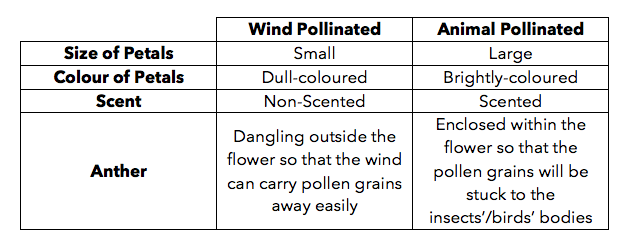Does your child often get confused over the dispersal of pollen grains and the dispersal of seeds? What’s the difference?
In the first article from our All About Plants Series, we will be clarifying this misconception!
Here’s what happened in class recently:
Me: Class, what are the agents of dispersal for pollen grains?
Class: Wind.
Me: *nods* What else?
Class: Animals!!!
Me: *nods*
Class: Wind!!! Splitting!!!
Me: *Wide gaping mouth* 😮
This is a common misconception among students as wind and animals are both methods of dispersal for seeds and pollen grains.
Read Also
Students tend to consider the different types of seed dispersal together with the agents of dispersal of pollen grains, causing them to lose substantial marks in both multiple-choice questions and open-ended questions.
Agents of Pollination
In order for flowering plants to develop fruits, flowers need to be pollinated.
Pollination is the transfer of pollen grain (that contains the male reproductive cell) from the anther (male reproductive part) to the stigma (female reproductive part).
For pollen grains to be transferred from the anther to the stigma, some external help is needed!
There are two classifications for the agents of pollination:
- Wind
- Animals (Insects/Birds)
There are a few distinguishable characteristics between wind-pollinated flowers and animal-pollinated flowers as shown in the table below:

Questions testing on agents of pollination would typically have diagrams on flowers illustrating the distinguishable parts.
Here’s An Example

Looking at the diagrams, we can observe that Flower A has larger petals than Flower B and the anthers of Flower B are dangling outside as compared to the anthers of Flower A which are enclosed within the flower.
Hence, it can be concluded that Flower A is animal-pollinated whereas Flower B is wind-pollinated.
With this information, students can go on to tackle the application part of the question.
Dispersal of Seeds/Fruits
After the flower has been pollinated and fertilised, the ovary will swell and develop into a fruit.
In order for seedlings to grow healthily, it is important for seeds to be dispersed further away from the parent plant.
Importance of Seed Dispersal
A commonly tested question is:
Why is it important for seeds to be dispersed further from the parent plant?
There are a few key points that are required in the answer:
- Prevents overcrowding
- Reduces competition between the parent plant and the seedlings for:
- Space
- Sunlight
- Water
- Mineral salts
- For healthier growth of the seedlings
Thus, the answer would be,
‘It is to prevent overcrowding and reduce competition between the parent plant and the seedlings for space, sunlight, water and mineral salts, to ensure healthier growth of the seedlings.’
Types of Seed Dispersal
There are a total of 4 types of seed dispersal:
- Wind
- Animal
- Water
- Splitting/ Explosive Action
As mentioned above, agents of pollination and methods of seed dispersal have their respective characteristics.
With a better understanding of these characteristics, students can avoid misconceptions between dispersal of pollen grains and dispersal of seeds.
In the next series, I would be going more in-depth into the dispersal of seeds and how to distinguish the types of dispersal of seeds based on their dispersal patterns.
Stay tuned! 🙂

If you like our methodology, we’ve some upcoming workshops:







